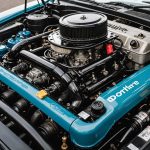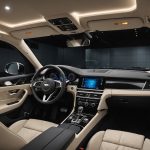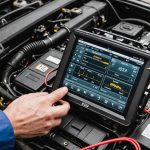Understanding the Automatic High-Beam System
The automatic high-beam system is designed to enhance driving visibility during nighttime, providing an improved and safer driving experience. This system automatically switches between high and low beams based on traffic conditions, contributing to optimal road illumination.
Using sensors and onboard cameras, it detects surrounding vehicles and adjusts the beam accordingly, ensuring that oncoming drivers are not blinded while maximising visibility for the driver using it.
Also to discover : Ultimate handbook: optimal steering fluid inspection frequency for high-mileage vehicles to prevent steering system breakdown
One of the primary benefits of the automatic high-beam is enhanced safety. By automatically managing the lights, it reduces the need for drivers to manually switch beams, allowing them to keep their focus on the road. This is particularly crucial during nighttime driving when visibility is naturally reduced.
The system improves visibility by extending the illuminated distance, thereby helping drivers to spot hazards earlier. Factors such as road lighting, weather conditions, and vehicle speed can influence its effectiveness. Therefore, ensuring that the system is well-maintained and configured correctly is essential for it to function optimally.
Familiarity with the automatic high-beam’s operation can significantly benefit drivers, providing confidence in safe nighttime travel.
Essential Maintenance Tips for the High-Beam System
Proper maintenance of the automatic high-beam system is vital to ensure its reliability and vehicle safety. Start by conducting regular checks and cleaning of the headlight lenses. Dirt or grime can obstruct light, reducing the beam’s efficiency and clarity. Gently clean the lenses to maintain optimal light output.
Software updates are equally crucial, as they can enhance functionality and address any identified glitches. Manufacturers may release patches that improve the system’s ability to adapt to diverse driving conditions.
Focus also on maintaining the light bulbs and sensors. Inspect bulbs for any signs of wear or damage, replacing them when necessary to ensure consistent illumination. Similarly, clean the sensors, as debris can compromise their ability to detect oncoming vehicles accurately.
Implement these practices consistently to prolong the system’s lifespan and effectiveness, ensuring safe and effective nighttime driving. These maintenance tips not only optimize performance but also significantly enhance driving safety on the road.
Adjusting the High-Beam System for Optimal Performance
Understanding how to adjust the high-beam system can significantly improve your driving experience and safety. For optimal performance, first ensure that the vehicle is on a level surface and check the alignment of the beams against a wall. This can help you gauge if the beam alignment requires fine-tuning to enhance driving safety.
To begin the alignment process, consult your vehicle’s manual for system-specific instructions. Adjusting for varying driving conditions, such as fog or heavy rain, can also be necessary. These conditions may require slightly lowering the beam to reduce glare and improve road visibility.
Recognition of when adjustments are essential is key. If you notice that road signs or other vehicles are not being adequately illuminated, it may be time to check your settings. Similarly, if oncoming drivers frequently flash their headlights at you, it could indicate that your beams are misaligned.
Maintaining awareness of your high-beam’s adjustment contributes greatly to driving safety. It ensures that you, the driver, are getting the most out of your visibility system while being considerate to other road users.
Troubleshooting Common Issues
Encountering high-beam problems can be frustrating, but certain issues are commonly seen. First, check if the automatic high-beam system responds inconsistently. If it does, ensure that sensors are clean and unobstructed. Dirty sensors often cause responsiveness issues, affecting safety.
If high-beams fail to switch automatically, investigate if software updates are pending. Delays in updates may hinder the system’s effective operation. Occasionally, a simple reset might resolve glitches. For quick fixes, consult the vehicle’s manual for steps to reset the electronic system.
Persistent problems, such as flickering or failed high-beams, may require professional intervention. Faulty light bulbs or software malfunctions could be the culprit. It’s advisable to visit a service center if these issues remain unresolved after basic troubleshooting attempts.
Safety solutions include verifying vehicle settings. Misaligned settings can reduce lighting efficiency, affecting night driving visibility. Hence, always ensure settings are adjusted correctly. Knowing these troubleshooting tips helps maintain safety and enhance the system’s functionality.
Additional Nighttime Driving Safety Practices
Driving at night requires extra caution to maintain visibility and ensure safety. Besides relying on the automatic high-beam system, a range of nighttime safety tips can further protect you on the road.
Regular vehicle maintenance is crucial for overall safety. This includes checking tire pressure, ensuring all vehicle lights function, and keeping windshields clean for unobstructed views. Clear windshields help in spotting road obstacles sooner.
In addition to the automatic system, employing driving precautions enhances safety. Reduce speed in poorly lit areas or during inclement weather conditions. This proactive approach allows more reaction time and reduces accident risks.
For optimal visibility strategies, avoid staring directly at oncoming lights to prevent temporary blindness. Instead, focus on road edges. If you encounter foggy conditions, using low beams, rather than high, improves visibility by reducing glare reflected from the fog.
Finally, be mindful of using high-beams responsibly with oncoming traffic. Dim your lights to avoid blinding other drivers, facilitating safer road sharing. By integrating these practices, you ensure a safer nighttime driving environment.











